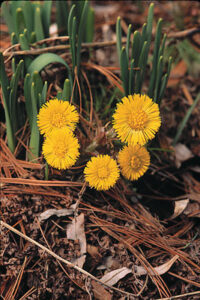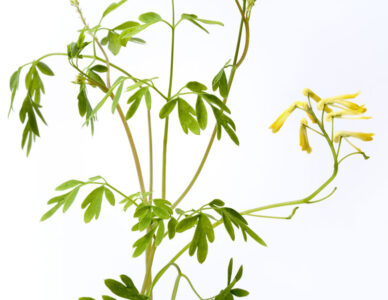• Tussilago farfara
• (Tuss-ih-LAY-go FAR-fuh-ruh)
• Family Compositae
• Perennial herb
The glow of coltsfoot’s cheerful golden flowers along roadsides and stream banks is a sure sign of spring. Though too invasive to be welcome in most gardens, coltsfoot once was highly esteemed for its ability to relieve coughs and asthma.
The genus Tussilago (Latin for “cough dispeller”) comprises either one or fifteen species of perennial herbs, depending on which botanist you consult. Coltsfoot (T. farfara) is native to Europe, western and northern Asia, and North Africa. In North America, it is found in the northeastern United States and adjacent Canada west to Minnesota and south to Maryland, Virginia, and Kentucky. It is hardy in Zones 3 to 7.
The 13/8-inch-wide flower heads on thick, scaly, reddish 6-inch stalks appear before the leaves (accounting for the alternate common name son-before-the-father, or filius ante patrem in Latin, as it was known during the Middle Ages). The flower head looks much like that of a dandelion but has a central disk like that of a daisy. Each narrow, petallike ray flower has a pistil (female organ) but no stamens (male organs). Each disk flower has both stamens and a pistil, but the latter is nonfunctional. The flowers, which open in sunshine and close in cloudy weather and at night, are usually pollinated by butterflies and bees.
Later on, rosettes of 6- to 8-inch-wide stalked green leaves arise from the creeping rhizomes. Some early botanists, observing the leafless flowers in one place and the flowerless foliage in another, concluded that they represented separate species. The irregular-toothed leaves apparently reminded many of animals’ feet: besides coltsfoot, common names include bullsfoot, ass’s foot (pas d’âne in French), and horsehoof. The sixteenth-century English herbalist John Gerard asserts, however, that the specific name farfara comes from a resemblance of the leaf shape to that of white poplar, “which was named of the Antients Farfarus.” Both the upper and lower leaf surfaces are at first covered with hairs, but those on top fall off as the leaf expands. The mature leaves are smooth and green above, felty and white below. The soft hairs, when wrapped in a rag dipped in saltpeter and dried in the sun, have been used as tinder. The entire plant may grow to a height of 20 inches.
The seed heads are fluff balls like those of dandelions. European goldfinches and American indigo buntings use this down to line their nests, and it is said that Scots Highlanders once used it to stuff pillows.
Medicinal Uses for Coltsfoot
Coltsfoot was so well known as a medicinal herb in olden times that a painting of its leaf on Paris apothecaries identified them to the illiterate. Teas of the fresh leaves, roots, or flowers have been given to soothe sore throats, coughs, and asthma. They have a licoricelike flavor. Syrups and cough drops are even more palatable; a traditional British cough drop was called Coltsfoot Rock. Coltsfoot leaves, flowers, or flower buds might also be smoked. The Roman naturalist Pliny (a.d. 23-79) advised burning the leaves and roots over cypress charcoal and then inhaling the smoke through a reed and swallowing it, this to be done alternately between sips of wine.
External applications of coltsfoot have treated varicose veins, wounds, sores, insect bites, and inflammations of the skin. One preparation combined the crushed fresh leaves with honey. Coltsfoot-water compresses were recommended to soothe hemorrhoids.
Mucilage in the leaves is likely the substance responsible for calming irritated mucous membranes, but because the mucilage would be destroyed on burning, it would be unavailable to anyone smoking the herb. In fact, Varro Tyler points out that the smoke would tend to exacerbate irritated bronchial passages.
Despite its apparent effectiveness in relieving coughs, coltsfoot, like comfrey, contains pyrrolizidine alkaloids, which when ingested in large amounts can cause irreversible liver damage. About twenty-five years ago, Japanese researchers examined the effect of feeding large quantities of “pre-blooming” coltsfoot flowers to a small number of laboratory rats. Although all lived throughout the 380 days of the study, eight of the twelve receiving a 32-percent coltsfoot diet developed a kind of liver cancer. Only one of the ten rats on the 8-percent coltsfoot diet and none on the 4-percent diet developed cancer. The cancers were attributed to senkirkine, one of the pyrrolizidine alkaloids. Although the German health authorities have established standards for herbs containing pyrrolizidine alkaloids, they are not in force in this country. Whether you buy dried coltsfoot leaves or gather fresh ones, you have no way of knowing whether your tea or other preparation is safe to consume. Better to choose from among such safe and effective herbal throat soothers as slippery elm bark, marsh mallow root, mullein flowers, and plantain leaves.
In the past twelve years, coltsfoot’s traditional use in Chinese medicine to treat respiratory disorders has led a few scientists to try to isolate its active components and examine their properties. One component, tussilagone, proved to be a potent cardiovascular and respiratory stimulant in a study using laboratory dogs, cats, and rats. In another study, an isolate from an extract of the flower buds was found to relax preparations of rat blood vessels and also to inhibit two kinds of chemically induced edema (accumulation of fluid) in laboratory rats. Whether these effects can be harnessed to benefit humans without the risk of causing cancer remains to be seen.
Other Uses for Coltsfoot
Young coltsfoot leaves have been eaten raw in salads (they are rich in vitamin C) or cooked in soups or as a potherb. The stems, which look a little like puny asparagus stalks, have stood in for that vegetable in an emergency. The flowers have been used to make a wine (presumably similar to dandelion wine). Coltsfoot also has been used in herbal and regular tobacco blends. One writer who tested a claim that the ash may be used as a salt substitute found that it just tasted like ash.
Growing Coltsfoot
Coltsfoot spreads too vigorously for the herb garden; in fact, it is said that the underground stems can remain quiescent underground for years and then sprout exuberantly when the ground is disturbed. If you must have it, try confining it in a bottomless pot or growing it in a container. It is good in a wild garden or as a ground cover to stabilize banks.
Coltsfoot is most easily grown from divisions, but it may also be propagated from seeds or root cuttings. The seeds soon die in dry storage but germinate readily when fresh. In one study, 100 percent of seeds dried for six months failed to germinate whereas 100 percent of fresh seeds germinated within twelve days whether kept at 70° or 40°F.
Coltsfoot prefers moist, neutral to alkaline soil in full sun but will tolerate partial shade. The leaves are cut when full grown, say in June or July, and used fresh or dried. Some people like to use the leaves as compost, perhaps after they find out how fast the plants spread. Flowers are picked when they first open.
Sources
• Companion Plants, 7247 N. Coolville Ridge Rd., Athens, OH 45701. (740) 592-4643. Catalog $3. Plants.
• Goodwin Creek Gardens, PO Box 83, Williams, OR 97544. (541) 846-7357. Catalog $1. Plants.
• Richters, Goodwood, ON, Canada L0C 1A0. (905) 640-6677. Catalog free. Fresh or cold-stored seeds, plants, dried leaves.
• Sandy Mush Herb Nursery, Rt. 2, Surrett Cove Rd., Leicester, NC 28748. (828) 683-2014. Catalog $4. Plants.
• The Thyme Garden, 20546 Alsea Hwy., Alsea, OR 97324. (541) 487-8671. Catalog $2. Plants.







